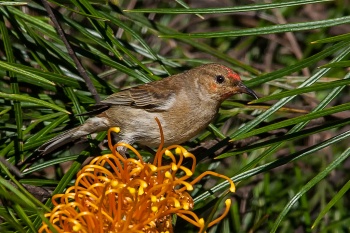m (→External Links) |
|||
| (10 intermediate revisions by 5 users not shown) | |||
| Line 1: | Line 1: | ||
| + | '''Alternative name: Scarlet Honeyeater''' | ||
| + | [[Image:Scarlet_Honeyeater.jpg|thumb|500px|right|Photo by {{user|Tom+Tarrant|Tom Tarrant}}<br /> Samsonvale, south-eastern [[Queensland]], [[Australia]]]] | ||
| − | ; | + | ;[[:Category:Myzomela|Myzomela]] sanguinolenta |
| − | [[ | ||
==Identification== | ==Identification== | ||
| − | 10-11 cm | + | 10-11 cm<br /> |
| + | Black bill and eye<br /> | ||
| + | Male | ||
| + | *Red head, breast, back and rump | ||
| + | *Black tail and wings (wing feathers have white margins) | ||
| + | *White abdomen<br /> | ||
| + | [[Image:FDSCF8806 female scarlet-1.JPG|thumb|250px|right|Female<br />Photo by '''[http://www.birdforum.net/member.php?u=16212 Mat & Cathy]'''<br />Oxley Creek Common, Brisbane, [[Queensland]], [[Australia]]]] | ||
| + | Female: pale brown; whitish abdomen | ||
==Distribution== | ==Distribution== | ||
| − | + | Eastern [[Australia]] (Cooktown, [[Queensland]] to east [[Victoria]]). | |
==Taxonomy== | ==Taxonomy== | ||
| + | This is a [[Dictionary_M-O#M|monotypic]] species<sup>[[#References|[1]]]</sup>. | ||
| + | |||
==Habitat== | ==Habitat== | ||
| − | + | Mixed Eucalypt forest with paperbarks and bushland. | |
==Behaviour== | ==Behaviour== | ||
| + | ====Diet==== | ||
Its diet includes nectar and insects. | Its diet includes nectar and insects. | ||
| + | ====Breeding==== | ||
| + | [[Image:ScarletHoneyeater 0367 sw.jpg|thumb|350px|right|Juvenile<br />Photo by {{user|kerriebr|kerriebr}}<br />Gold Coast, [[Queensland]], August 2013 ]] | ||
| + | The tiny nest is found high in the canopy. It is formed from bark held together with spider web. The small white eggs have reddish-brown or purple flecks. | ||
| + | ==References== | ||
| + | #{{Ref-Clements6thAug13}}#Avibase | ||
| + | #Wikipedia | ||
| + | {{ref}} | ||
| + | ==External Links== | ||
| + | {{GSearch|"Myzomela sanguinolenta" {{!}} "Scarlet Myzomela" {{!}} "Scarlet Honeyeater"}} | ||
| + | {{GS-checked}}1 | ||
| + | <br /> | ||
| + | <br /> | ||
| − | |||
| − | + | [[Category:Birds]] [[Category:Myzomela]] | |
| − | |||
| − | |||
| − | [[Category:Birds]][[ | ||
Latest revision as of 18:07, 8 April 2023
Alternative name: Scarlet Honeyeater
- Myzomela sanguinolenta
Identification
10-11 cm
Black bill and eye
Male
- Red head, breast, back and rump
- Black tail and wings (wing feathers have white margins)
- White abdomen
Female: pale brown; whitish abdomen
Distribution
Eastern Australia (Cooktown, Queensland to east Victoria).
Taxonomy
This is a monotypic species[1].
Habitat
Mixed Eucalypt forest with paperbarks and bushland.
Behaviour
Diet
Its diet includes nectar and insects.
Breeding
The tiny nest is found high in the canopy. It is formed from bark held together with spider web. The small white eggs have reddish-brown or purple flecks.
References
- Clements, J. F., T. S. Schulenberg, M. J. Iliff, B.L. Sullivan, C. L. Wood, and D. Roberson. 2013. The eBird/Clements checklist of birds of the world: Version 6.8., with updates to August 2013. Downloaded from http://www.birds.cornell.edu/clementschecklist/download/
- Avibase
- Wikipedia
Recommended Citation
- BirdForum Opus contributors. (2024) Scarlet Myzomela. In: BirdForum, the forum for wild birds and birding. Retrieved 27 December 2024 from https://www.birdforum.net/opus/Scarlet_Myzomela
External Links
GSearch checked for 2020 platform.1






